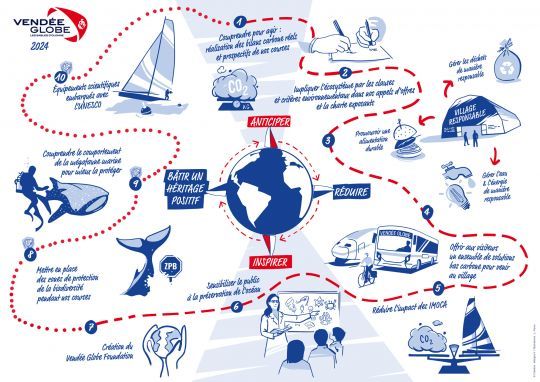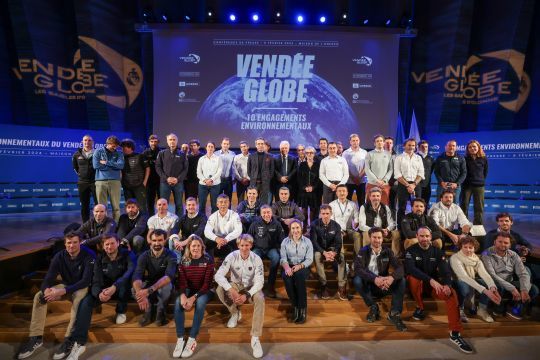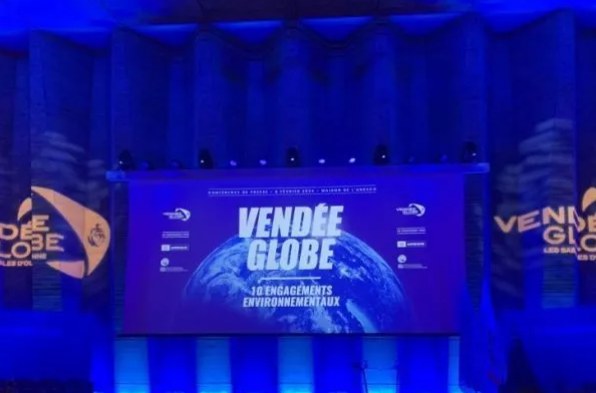On February 6, 2024, the Vendée Globe held a press conference attended by the 44 skippers competing in the 10th edition of the round-the-world race next November. Alain Leboeuf, president of the race, unveiled 10 environmental commitments made by the organization to reduce its impact on the environment.
The Vendée Globe is France’s most talked-about sailing event, even among the general public. The 2020-2021 edition was followed by 66% of French people. It is also an increasingly international event, with 11 nationalities and 16 international skippers represented in the 2024 edition. A record number! With this in mind, Alain Leboeuf, President of the Vendée Departmental Council and President of the Vendée Globe, and his team have decided to make strong environmental commitments.
As a preamble, he explains: « We’re going to bring changes to the Vendée Globe by bringing this extra dimension of environmental commitments to this extreme race. We need to raise awareness, raise consciousness, support the preservation of the oceans, particularly for the public who support us. »
So it was at UNESCO headquarters on February 6, 2024 that we gathered to discover the 10 commitments in force from this 10th edition of the Vendée Globe, which will set off on November 10, 2024. These commitments will continue for the 2028 edition, and continue to evolve in 2032.
The Vendée Globe’s approach is based on four pillars:
- Anticipate,
- Reduce,
- Inhale,
- Building a positive legacy.

Anticipating to define a pioneering method for nautical events
As Alain Leboeuf trained as a biologist, it was important for him to work on the impact of the Vendée Globe. In collaboration with Carbone 4 and Toovalu, experts in the field, they worked on defining an evaluation method dedicated to the organization of nautical events. The organization applied a forward-looking carbon footprinting approach to identify the main impacts of the Vendée Globe 2024 and then act on the levers for reduction. The next step will be to measure the first results of a real carbon footprint to validate the methodology, and measure the results of the actions implemented.
Today, the impact of the Vendée Globe is distributed as follows:
- 63% for travel
- 28% for accommodation and catering
- 7% for IMOCA boats
- 2% for purchasing, waste, water, energy and digital.

Reduce by applying the 5Rs rule
As a prescriber, the Vendée Globe has decided to add strict environmental clauses to its invitations to tender. Exhibitors also benefit from a charter on the circular management of resources. With a view to reduce the impact of the village the Vendée Globe has applied the 5Rs rule:
- Refuse when possible,
- Reduce,
- Reuse,
- Recycle
- Return to the earth what can be composted.
To this end, a green brigade has been set up for exhibitors and the public, and water fountains will be installed in the village, replacing plastic bottles. To demonstrate its objective, the organization went so far as to provide water bottles to the skippers at the press conference. Perhaps a questionable and unsustainable communication stunt, if each skipper has to use a water bottle at each conference, rather than bringing his own…
The village’s signage will also promote the circular economy, with the reuse or second life of materials.
The other reduction lever is to decarbonizing visitor visits by promoting soft mobility. The organization is also counting on a strong « Don’t come to Les Sables… Alone ». To encourage people to change the way they travel, the Vendée Globe, together with public and private players such as the Département de la Vendée, the town and conurbation of Les Sables-d’Olonne, the Pays de la Loire Region, the SNCF Group, En Vendée, SyDEV, and ADEME, have set up a comprehensive range of low-carbon mobility solutions. The president of the Vendée Globe strongly emphasized « the train that comes to the heart of the city » and wants to encourage visitors to use this means of transport. The Region will be offering a ?5 ticket to Les Sables-d’Olonne. On site, visitors will be able to use natural gas shuttles, hydrogen buses, electric sea buses, self-service bicycles…
Finally, the third lever of reduction consists in reduce the impact of boats . Although navigators use only wind power to move around, on-board instruments still require the use of fossil fuels. As for fuel, it is used very little, mainly for safety reasons. Like the Watt & Sea hydrogenerators, developed in 2008 and now installed on the entire Vendée Globe fleet, new solutions will have to be found. Alain Leboeuf explains: « In 2028, we’ll have to show all peoples that we’re capable of using the power of wind, photons and displacement to make our own electricity. We’ll continue towards 2032 to invent solutions using new technologies. »
Some skippers have already taken the plunge, like Conrad Colman, who completed his fossil-free round-the-world voyage in 2016. For this 10th edition, his boat will be covered with solar panels, and the diesel heater replaced by an electric one.
The IMOCA class is also working on the subject to set new commitments for 2028, the Cap Carbone, aimed at limiting CO2 emissions in the construction of new boats. The aim is to reduce carbon footprint by between 15% and 25%.
Acting as experimentation centers, they enable the development of technologies that can later be applied more broadly to the marine industry.
Antoine Mermod, president of the IMOCA class presents : « For the past three years, the IMOCA class has been carrying out major work to analyze the life cycle of boats. 14 new boats have been built, for which we have set up an LCA – life cycle analysis, in an accounting way, with the same software, the same team, to quantify and analyze the real impact of these boats. They were built differently, by different people, in different places. We were able to deduce that certain materials are better than others, certain construction techniques are inadvisable… »
Like Conrad Colman, other skippers have taken similar initiatives. Jean Le Cam and Eric Bellion have chosen to build their two identical boats in a sober, mutualized fashion. This choice has enabled them to reduce their carbon footprint by a third, as well as saving time and money.
Damien Seguin has opened the door to the use of bio-sourced materials, with the help of a gauge. He uses a mainsail made of 40% linen. It has already completed a double transatlantic race and remains in perfect condition. If the tests are conclusive after the next two transatlantic races, the sailor will take it on board for his round-the-world voyage.

Inspiring public awareness of ocean preservation
« Our duty is to raise public awareness of the ocean » . This is how Alain Leboeuf introduced the 3rd axis of this approach. The Vendée Globe will take advantage of this 10th edition to deliver content to Internet users, based on in-depth articles produced in collaboration with several partners: Ifremer (French Research Institute for Exploitation of the Sea), TAAF (French Southern and Antarctic Territories), Polar Journal (online media dedicated to the polar zones) and Océans Connectés (online media entirely dedicated to marine sciences).
The organization will also be strengthening its Vendée Globe Junior educational program, which will now also be broadcast in English to reach all populations.
Building a positive legacy by launching the Vendée Globe Foundation
SAEM Vendée and the Département de la Vendée have created the « Vendée Globe Foundation » endowment fund with three founding members: Caisse Régionale du Crédit Agricole Mutuel Atlantique Vendée, Caisse Fédérale du Crédit Mutuel Océan and Banque Populaire Grand Ouest. The purpose of the fund is to finance research projects aimed at preserving marine ecosystems. Alain Leboeuf explains: « We need to popularize science and communicate. We’re going even further by launching a Vendée Globe Foundation to raise funds and finance a certain amount of concrete research into the preservation of marine ecosystems in connection with the skippers’ round-the-world journey. »
Sodebo, a long-standing partner of the Vendée Globe, is the first sponsor. Others are likely to follow, as sponsors are so fond of these schemes, which are both attractive from a media and tax point of view. Three projects have already been supported under this scheme.
Share The Ocean
The Vendée Globe will be working with a consortium of experts to delineate biodiversity protection zones. Starting in 2024, they will try to identify the most important zones – breeding or feeding grounds – to minimize collisions with marine megafauna along the route.
The William Mission of the Over The Swell association
The William mission was a real coup de coeur for the Vendée Globe. The aim is to better understand the migratory routes of the whale shark, in order to protect it more effectively.
Research collaboration with UNESCO
For the past 10 years, some skippers have been taking sensors on board to enrich scientific databases, particularly in little-visited areas such as the Southern Ocean. To lend credibility to the 10 Commitments project, the Vendée Globe has entered into a partnership with UNESCO to finance the coordination of oceanographic measuring instruments. While some skippers will already be able to embark certain instruments in 2024, the obligation will be implemented in 2028.


